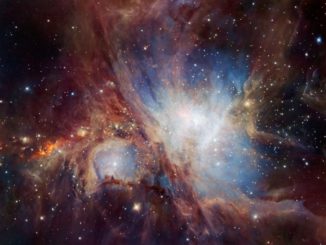
Astronomers probing the early universe have found a gigantic proto-supercluster of galaxies just 2.3 billion years after the Big Bang birth of the cosmos. Nicknamed Hyperion, the structure is the most massive yet found in the early universe with more than one million billion times the mass of the sun.
“This is the first time that such a large structure has been identified at such a high redshift, just over 2 billion years after the Big Bang,” said Olga Cucciati of Istituto Nazionale di Astrofisica in Bologna. “Normally these kinds of structures are known at lower redshifts, which means when the Universe has had much more time to evolve and construct such huge things. It was a surprise to see something this evolved when the Universe was relatively young.”
Cucciati and an international team of astronomers found the proto-supercluster in the constellation Sextans using the VIMOS instrument on the European Southern Observatory’s Very Large Telescope. The structure was identified in data collected by the VIMOS Ultra-Deep Survey, which mapped the distribution of 10,000 galaxies in the very distant universe.
“Superclusters closer to Earth tend to a much more concentrated distribution of mass with clear structural features,” said Brian Lemaux, an astronomer with the University of California-Davis and a co-leader of the team. “But in Hyperion, the mass is distributed much more uniformly in a series of connected blobs, populated by loose associations of galaxies.”
The difference is likely due to the hugely greater time nearby superclusters have had to pull material into denser regeions, a process that has not been going on nearly as long in Hyperion.
his contrast is most likely due to the fact that nearby superclusters have had billions of years for gravity to gather matter together into denser regions — a process that has been acting for far less time in the much younger Hyperion.
Astronomers expect Hyperion to evolve into something similar to the more familiar Virgo supercluster, the vast assembly of galaxies that is home to Earth’s Milky Way.
“Understanding Hyperion and how it compares to similar recent structures can give insights into how the Universe developed in the past and will evolve into the future, and allows us the opportunity to challenge some models of supercluster formation,” said Cucciati. “Unearthing this cosmic titan helps



